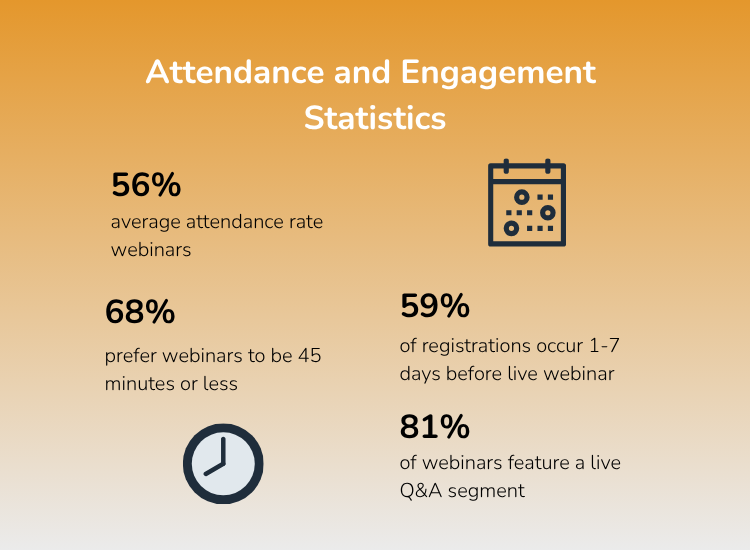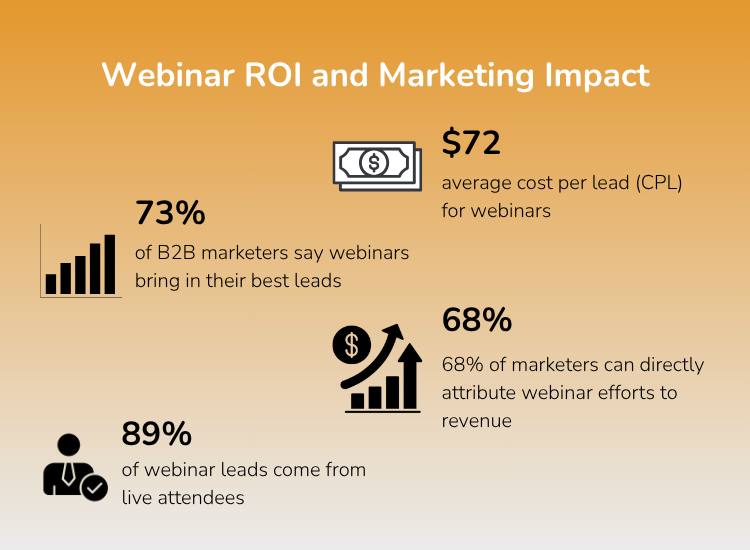



Webinars have become one of the most impactful ways to connect with audiences in 2025. They bridge the gap between in-person interaction and online convenience, offering a platform for education, lead generation, and engagement that few other formats can match. Backed by fresh statistics and trends, it’s clear that webinars aren’t just a passing trend—they’re now a key fixture in marketing, training, and professional communication strategies.
In this article, we’ll explore the most relevant webinar statistics for 2024–2025, including insights on usage patterns, attendance rates, engagement behavior, and ROI. These figures will help you plan, host, and evaluate webinars more effectively, no matter your industry or goals.
.png)
Webinars continue to rise in popularity across industries. Recent studies show that 95% of marketers consider webinars important to their strategy, and 73% of B2B marketers say webinars are their top source of high-quality leads.
More than 64% of B2B marketers hosted a webinar or virtual event in the past year, underscoring how common this format has become. Many organizations have ramped up webinar production: 41.7% of companies increased their webinar frequency year-over-year, and 57% of marketers host up to 50 webinars annually – nearly one per week. This surge is fueled by the effectiveness of webinars in engaging audiences remotely.
The global webinar market and technology spend reflect this growth. Worldwide investment in webinar and virtual event platforms is projected to reach $4.4 billion in 2025, a clear sign that organizations are doubling down on webinar tools. Webinars have proven their value for lead generation and content delivery, especially as in-person events remain limited or expensive.
Notably, webinars are extremely cost-effective compared to physical events – the average cost per lead from webinars is around $72, versus more than $800 per lead at trade shows. Such statistics emphasize why webinars deliver strong ROI and why marketers rank them among the best-performing content formats (51% of content marketers said webinars produced the best marketing results in the last year).
Another emerging trend is the integration of AI and automation in webinars. An overwhelming 98% of marketers plan to enhance webinars with AI within the next year. Already, 87% of B2B marketers use AI in their webinar strategy, leveraging tools for tasks like content repurposing, automated follow-ups, and audience analytics.
This has tangible benefits – for example, using AI to repurpose webinar recordings into blogs, clips, and social posts saved marketers an estimated 13,000 hours (≈$650,000) in 2024. These webinar trends show that 2025’s webinars are not just more frequent; they are smarter and more efficient, powered by data and AI.

Getting people to register and attend is a core challenge for webinar hosts. Recent webinar statistics offer insight into attendance patterns. On average, 40% to 50% of webinar registrants attend live. Top-performing webinars can see attendance rates as high as 90% of registrants, but a typical webinar converts about 57% of registrations to actual attendees.
In raw numbers, one major platform reported the average webinar had 284 sign-ups with a 57.9% attendance rate, meaning roughly 164 people attend out of 284 registrants on average. However, most webinars are fairly small in live audience size – about 75% of webinars have fewer than 50 live attendees. (This suggests that while some webinars attract hundreds of attendees, the majority serve niche audiences or internal teams.)
When do people register and attend? Timing is key. Nearly 59% of webinar sign-ups occur within the week before the event, and 29% of people register on the very same day as the webinar. This last-minute registration trend means promotion and reminder efforts should continue right up until the event.
As for the best scheduling, mid-week webinars tend to perform best. Wednesdays, in particular, see the highest live attendance rates – one 2025 analysis found Wednesday webinars achieve about 48% attendance (higher than any other day. Meanwhile, Thursdays tend to drive the most registrations (around 30% higher sign-up volume than other days).
The optimal time of day is late morning or early afternoon. 38% of webinars now start at 11AM (local time), which has become the most common time slot, and hosting webinars around lunchtime or early afternoon yields strong turnout. Interestingly, data also shows webinars held at 2PM have the highest average attendance rate (around 55%), likely because this time balances multiple time zones and fits well into work schedules.
Webinar duration is another factor in engagement. Audience attention spans typically last around 45–60 minutes in a webinar setting. While some content can stretch to 90 minutes (and indeed 90-minute webinars have been observed to achieve the highest attendance rates among those who register), shorter sessions tend to maintain attention better.
According to surveys, 68% of attendees prefer webinars that are 30–45 minutes long, considering this the ideal duration. In practice, even if a webinar is scheduled for an hour, attendees often drop off earlier – for example, one report noted that for a 60-minute webinar, the average attendee only watches about 42 minutes. Overall, the average viewing time for webinar attendees is roughly 50–57 minutes, so planning your content to fit within an hour (or less) is wise to maximize engagement.
Because not everyone can attend live, on-demand viewing plays a huge role in total audience. Approximately 45%–47% of webinar attendees watch the content on-demand (as a replay) rather than live.
In other words, nearly half of all webinar views now come from post-event replays. This underscores the importance of recording webinars and making replays available – many interested people will engage at their own convenience. In fact, sending out a “watch on-demand” link promptly can dramatically boost replay views.
One benchmark showed that nearly half of all replay views (48%) occur via links sent within 24 hours after the live event. Combining live webinars with easy-access recordings extends your reach and total engagement.
Audience engagement during webinars is equally important. Attendees don’t want to just sit and listen; they expect interactive elements. Most webinars include Q&A sessions – around 81% of webinars feature a live Q&A segment for attendees, and 92% of attendees say a live Q&A at the end is a must-have. This indicates that nearly everyone expects a chance to ask questions and interact with presenters.
Polls are another popular tool, though their use has room for growth. Roughly 44% of webinar hosts incorporate live polls in their sessions, a number that has been increasing year-over-year. Polls are effective for keeping viewers engaged; typically 50-55% of attendees will respond to polls on average, and the best webinars see poll response rates above 60%.
Moreover, top hosts tend to run a poll every 15–30 minutes to maintain interactivity. Other interactive content is also used: about 69% of webinars offer downloadable resources for attendees (like slides or handouts), and some use surveys, group chat, or social media elements to drive participation.
The takeaway from these webinar engagement statistics is that interaction is key to a successful webinar. Features like Q&A and polls significantly boost attentiveness and satisfaction. It’s also apparent that convenience (through on-demand access) and smart timing (scheduling mid-week at optimal times) can substantially improve who shows up and how long they stay.

Webinars in 2025 are not just about engagement – they are delivering real ROI for organizations. In terms of lead generation and sales impact, webinars rank extremely high.
As mentioned, 73% of B2B marketers rate webinars as their #1 source of high-quality leads, and 51% of content marketers said webinars yielded their best marketing results in the past year. Attendees attracted to webinars tend to be genuinely interested in the topic, which makes them valuable leads.
On average, companies report that 20% to 40% of webinar attendees turn into qualified leads in the sales pipeline. These conversion rates are impressive – a well-run webinar doesn’t just draw an audience, it can directly feed a chunk of that audience into your customer acquisition funnel.
One reason webinars drive strong ROI is their cost-effectiveness. As noted, the cost per lead (CPL) for webinars averages around $72, which is far lower than many other channels. For perspective, in-person trade shows often exceed $800 per lead when factoring travel and booth costs.
Even digital advertising can have higher CPL for equivalent quality. Thus, webinars deliver a high return on investment by generating engaged leads at a relatively low cost. Additionally, most webinar platforms allow unlimited attendees for a fixed cost, so scaling up audience doesn’t drastically increase expenses – another ROI advantage over physical events.
Webinars also contribute to revenue more directly than just lead generation. According to research by webinar platform ON24, 68% of marketers in recent years were able to attribute webinars to actual revenue generation. These events also tend to lower overall marketing spend by replacing pricier tactics (75% of marketers said webinars helped reduce their cost-per-lead).
In 2024, as webinars became more interactive, there were notable jumps in buyer engagement during webinars. For example, one benchmark found a 3× increase in live meeting bookings and a 51% increase in live chat with sales reps during webinars (compared to previous years). This means webinar attendees are increasingly taking immediate next steps – such as requesting demos or engaging sales – right in the webinar environment, accelerating the sales cycle.
The live vs. on-demand dynamic also has ROI implications. Live webinars are particularly powerful for capturing new leads – in fact, 89% of webinar leads come from live attendees, versus 11% from on-demand viewers. Live events create urgency and interaction that prompt people to sign up and engage.
However, on-demand content extends the long-tail value of that webinar by continuing to generate interest and smaller trickles of leads over time. The best strategy is to leverage both: use the live session for its lead generation punch, then use the recorded webinar as evergreen content (gated on your website, for example) to passively collect additional leads.
In summary, the ROI of webinars in 2024-2025 remains very high. They are a top lead-gen tactic for marketers, produce tangible sales opportunities, and do so at a fraction of the cost of traditional events. Businesses in all sectors – from B2B tech to education providers – are finding webinars to be an essential, cost-efficient way to reach a wide audience, build trust, and drive conversions.
Webinar best practices can be applied by anyone, but each audience type tends to focus on different priorities and goals.
Want to go deeper into specific aspects of webinars? Check out these related guides:
Webinars in 2025 are a powerful medium bridging content marketing, virtual events, and online education. The latest webinar statistics show a medium that is still growing and evolving – more webinars are being held than ever, with higher attendance and engagement rates as organizations learn what works. Key webinar trends like shorter formats, interactive features, and AI-driven content repurposing are shaping how webinars are executed.
To significantly improve webinar outcomes, prioritize scheduling at optimal times, delivering valuable and concise content, and actively involving your audience through Q&As and polls. These strategies result in higher attendance, more engaged participants, and greater ROI through leads and conversions. Remember, authenticity and human connection are key to successful webinars. They allow for direct communication that builds trust more effectively than static content.
In summary, webinars remain an essential strategy for businesses, educators, and marketers in 2025. The combination of compelling statistics and best practices provided here should equip you to host webinars that inform, inspire, and convert. Use this data-driven approach to plan your next webinar, and you’ll be on track to create your most successful virtual event yet!
References:
Hubilo: Webinar Marketing Statistics and Benchmarks for 2025
Zoom: 21+ webinar statistics every business should know in 2025
Visitor Queue: What’s the Average Cost Per Lead for Different B2C Marketing Channels in 2024?
Kaltura: The State of Webinar
Contrast: 56 Webinar Statistics You Need to Know
ON24: Key Takeaways from the 2025 Webinar Benchmarks Report
TwentyThree: State of Webinars 2024
DemandSage: 40 Webinar Statistics 2025



